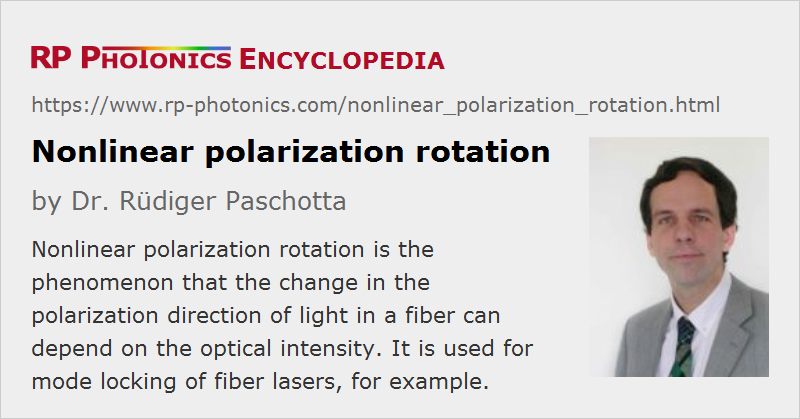Nonlinear Polarization Rotation
Definition: the phenomenon that the change in the polarization direction of light in a fiber can depend on the optical intensity
German: nichtlineare Polarisationsrotation
Categories: fiber optics and waveguides, nonlinear optics, light pulses
How to cite the article; suggest additional literature
Author: Dr. Rüdiger Paschotta
When an intense optical pulse propagates in an optical fiber which is not polarization-maintaining, there can be a nonlinear (i.e., intensity-dependent) change in the polarization state. This is usually not exactly a rotation of a linear polarization direction, but rather the change to some elliptical polarization state. The physical cause of these effects is related to self-phase modulation and cross-phase modulation as well as to some (uncontrolled) birefringence of the fiber. If the pulses then pass a polarizer, the power throughput effectively also depends on the optical power.
While nonlinear polarization rotation can be disturbing e.g. in systems with fiber amplifiers, it is also often utilized for passive mode locking of fiber lasers (→ mode-locked fiber lasers). Here, a typical configuration contains some fiber polarization controller or waveplates, which can be adjusted such that the maximum transmission (minimum loss) at the polarizer occurs for the highest possible optical intensity. The configuration then serves as an artificial saturable absorber. As the Kerr effect is very fast, this absorber is very fast, and its strength is adjustable with the polarization controllers. This makes mode locking with nonlinear polarization rotation a powerful technique. However, severe disadvantages are that the optimum polarization settings can drift with temperature, so that readjustment may often become necessary, and that it is difficult to experimentally quantify and reproduce the achieved modulation depth and saturation power.
A more environmentally stable mode-locking technique with nonlinear polarization rotation can be implemented by using a highly birefringent (polarization-maintaining) fiber and Faraday rotators [2]. That technique, however, is less easily implemented in the form of an all-fiber setup.
The technique of mode locking with nonlinear polarization rotation is sometimes also called polarization additive-pulse mode locking. Additive-pulse mode locking has originally been invented for bulk lasers. Here, interference occurs between beams which have propagated different ways in a laser setup, where they experienced different amounts of Kerr nonlinearity. On the other hand, nonlinear polarization rotation can be interpreted as interference of different polarization components which have traveled the same path. A difference is that cross-phase modulation can also occur in the case of nonlinear polarization rotation.
Questions and Comments from Users
Here you can submit questions and comments. As far as they get accepted by the author, they will appear above this paragraph together with the author’s answer. The author will decide on acceptance based on certain criteria. Essentially, the issue must be of sufficiently broad interest.
Please do not enter personal data here; we would otherwise delete it soon. (See also our privacy declaration.) If you wish to receive personal feedback or consultancy from the author, please contact him e.g. via e-mail.
By submitting the information, you give your consent to the potential publication of your inputs on our website according to our rules. (If you later retract your consent, we will delete those inputs.) As your inputs are first reviewed by the author, they may be published with some delay.
Bibliography
| [1] | M. Hofer et al., “Characterization of ultrashort pulse formation in passively mode-locked fiber lasers”, IEEE J. Quantum Electron. 28 (3), 720 (1992), doi:10.1109/3.124997 |
| [2] | M. E. Fermann, “Passive mode locking by using nonlinear polarization evolution in a polarization-maintaining erbium-doped fiber”, Opt. Lett. 18 (11), 894 (1993), doi:10.1364/OL.18.000894 |
| [3] | V. J. Matsas et al., “Self-starting passively mode-locked fibre ring soliton laser exploiting nonlinear polarisation rotation”, Electron. Lett. 28, 1391 (1992), doi:10.1049/el:19920885 |
| [4] | K. Tamura et al., “Self-starting additive pulse mode-locked erbium fibre ring laser”, Electron. Lett. 28, 2226 (1992), doi:10.1049/el:19921430 |
| [5] | F. Doutre et al., “Large temporal narrowing of subnanosecond pulses in a low-birefringence optical fiber”, Opt. Lett. 33 (16), 1789 (2008), doi:10.1364/OL.33.001789 |
See also: Kerr effect, cross-phase modulation, mode locking, passive mode locking, additive-pulse mode locking, fiber lasers
and other articles in the categories fiber optics and waveguides, nonlinear optics, light pulses
 |



If you like this page, please share the link with your friends and colleagues, e.g. via social media:
These sharing buttons are implemented in a privacy-friendly way!